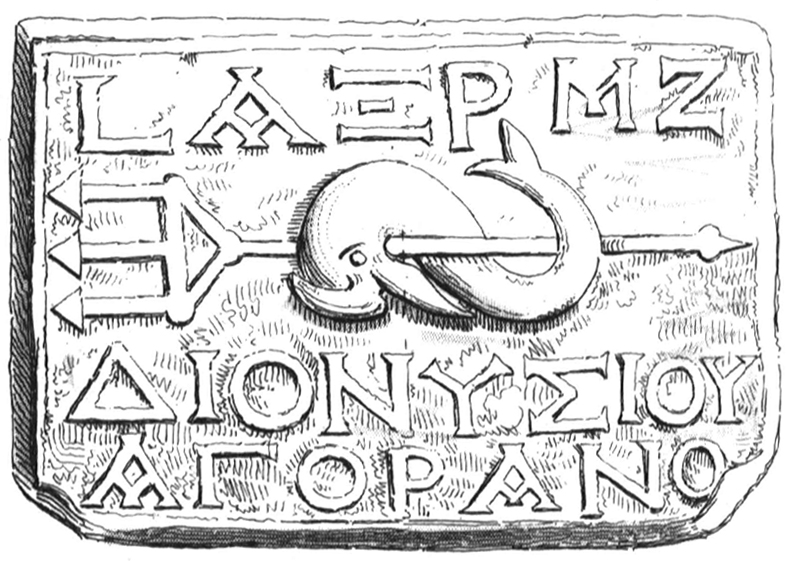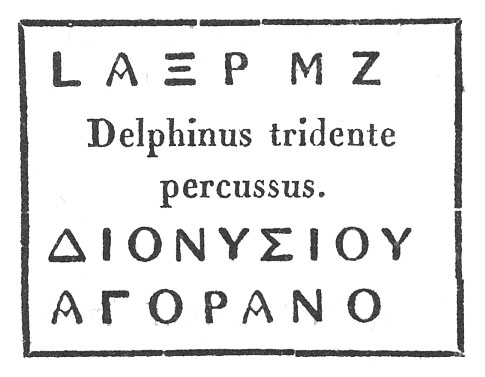
-
Copyright credit: Bibliothèque nationale de France / Louise Willocx
-
Copyright credit: Bibliothèque nationale de France / Louise Willocx
-
Copyright credit: Longpérier 1849

-
Copyright credit: Babelon and Blanchet 1895

-
Copyright credit: CIG IV

ARCHAEOLOGICAL DESCRIPTION OF THE WEIGHT
Authority
Dionysios I, agoranomos (Berytus)
Mint
Berytos
Denomination
1/2 Mina
Material
Lead
Manufacture
Cast
Shape
Rectangle
Length
6.80 cm
Width
4.60 cm
Height
0.70 cm
Metrology
| Mass (g) | Mass (grain) | Date of measurement | Reference | fragmented | cleaned | reference weight |
|---|---|---|---|---|---|---|
| 210.80 | - | Jan. 18, 2019 | Autopsy Louise Willocx | No | No | Yes |
| 273.00 | - | - | Babelon & Blanchet 1895 + BnF | No | No | No |
| 273.00 | - | - | Michon 1907 | No | No | No |
Iconography
| Symbol | Technique | Direction | Position | Number | Synecdoche |
|---|---|---|---|---|---|
| Dolphin | Relief | LEFT | |||
| Trident | Relief | LEFT |
Wear
Worn
Corrosion
Heavily corroded
Handle
No
Suspension hole
No
Recarved mould
No
Recarved weight
No
Intentionally destroyed
No
Archaeological description
Sawaya 2023: Rectangular lead cast weight Dimensions: 68 × 46 × 7 mm. Mass: 210.80 g on January 8, 2019 (originally 273 g). Preservation: very worn. [...]. Denomination: half mina. Obverse: dolphin entwined round horizontal trident to left (in center), LAΞΡ ΜΖ (above), ‘Year 161, half mina’, ΔΙΟΝΥΣΙΟΥ | ΑΓΟΡΑΝΟ (below), ‘Dionysios, being agoranomos’, all within a simple salient rectangular border. Reverse: blank. Agoranomos: Dionysios. Findspot: found by Brugnière and Olivier in 1794 in the ruins to the west of Beirut. Acquisition: Cabinet des médailles de la Bibliothèque nationale de France in Paris, inventory number Br 2250 (gift from L. Allier de Hauteroche, December 11, 1827). Photographic credits: Babelon and Blanchet 1895 (sketch); Bibliothèque nationale de France/Louise Willocx.
BnF: Demi-mine de Berytos, rectangulaire. Plomb. L. 7 cm; l. 4,7 cm; ép. 0,7 cm; Poids: 273 gr. LAΞP MZ/ΔIONYΣIOY/AΓOPANO. Un dauphin enlacé autour d’un trident. Poids trouvé en 1794 par Brugnière et Olivier, dans les ruines qui sont à l’ouest de Beyrouth (Longpérier, p. 344). La date se rapporte vraisemblablement à l’ère des Séleucides, et correspond, par conséquent, à l’année 151? av. J.-C. 161 av. J.-C.
Seyrig Archives (HS 332, no. 3): Poids rectangulaire. 70 mm. × 47 mm. Bordure saillante simple. Poids : 273 g. Dauphin enroulé sur un trident. L αξρ´, μ(ηνὸς) ζ´, | Διονυσίου | ἀγορανό(μου). Revers (...). Date : 7e mois de l’an 161 de l’ère des Séleucides = 141 av. J.-C. Cabinet de France, trouvé aux sables de Beyrouth.
Babelon & Blanchet 1895: Poids rectangulaire. Demi mine de Berytus. Sur l’une des faces, un dauphin enlacé autour d’un trident. Au dessus et en dessous des inscriptions: ΛΑΞΡ ΜΖ (Ἔτοῦς 161, μηνὸς 7) ΔΙΟΝΥΣΙΟΥ ΑΓΟΡΑΝΟ. Revers lisse. Plomb. Poids, 273 gr. (conservation défectueuse). Long. des côtés, 70 mill. sur 47. Trouvé, en 1794, par Brugnière et Olivier, dans les ruines qui sont à l’ouest de Beyrouth, ce poids fit partie de la collection d’Allier de Hauteroche, qui le légua au Cabinet des Médailles, en 1827. La date se rapporte vraisemblablement à l’ère des Séleucides, et correspond, par conséquent, à l’année 151 avant J.-C.
BnF: Demi-mine de Berytos, rectangulaire. Plomb. L. 7 cm; l. 4,7 cm; ép. 0,7 cm; Poids: 273 gr. LAΞP MZ/ΔIONYΣIOY/AΓOPANO. Un dauphin enlacé autour d’un trident. Poids trouvé en 1794 par Brugnière et Olivier, dans les ruines qui sont à l’ouest de Beyrouth (Longpérier, p. 344). La date se rapporte vraisemblablement à l’ère des Séleucides, et correspond, par conséquent, à l’année 151? av. J.-C. 161 av. J.-C.
Seyrig Archives (HS 332, no. 3): Poids rectangulaire. 70 mm. × 47 mm. Bordure saillante simple. Poids : 273 g. Dauphin enroulé sur un trident. L αξρ´, μ(ηνὸς) ζ´, | Διονυσίου | ἀγορανό(μου). Revers (...). Date : 7e mois de l’an 161 de l’ère des Séleucides = 141 av. J.-C. Cabinet de France, trouvé aux sables de Beyrouth.
Babelon & Blanchet 1895: Poids rectangulaire. Demi mine de Berytus. Sur l’une des faces, un dauphin enlacé autour d’un trident. Au dessus et en dessous des inscriptions: ΛΑΞΡ ΜΖ (Ἔτοῦς 161, μηνὸς 7) ΔΙΟΝΥΣΙΟΥ ΑΓΟΡΑΝΟ. Revers lisse. Plomb. Poids, 273 gr. (conservation défectueuse). Long. des côtés, 70 mill. sur 47. Trouvé, en 1794, par Brugnière et Olivier, dans les ruines qui sont à l’ouest de Beyrouth, ce poids fit partie de la collection d’Allier de Hauteroche, qui le légua au Cabinet des Médailles, en 1827. La date se rapporte vraisemblablement à l’ère des Séleucides, et correspond, par conséquent, à l’année 151 avant J.-C.
Autopsy
Yes
INSCRIPTION
| Language | Technique | Legend type |
|---|---|---|
| Greek | Relief | Authority, Date, Unidentified |
Fac simile
LΑΞΡ Μ<
ΔΙΟΝΥΣΙΟΥ
ΑΓΟΡΑΝΟ
Edition
(Ἔτους) αξρ´ (ἡμιμναῖον) | Διονυσίου | ἀγορανο(μοῦντος).
Monogram
ARCHAEOLOGICAL CONTEXT
Findspot (region)
Lebanon: Beyrouth (Bayrūt)
Findspot (site)
Beirut [Berytus / Laodicea / Laodikeia en te Phoinike / Col. Iulia Augusta Felix]
context
Found by Brugnières and Olivier in the ruins at the west of Berytus in 1794.
CIRCUMSTANCES OF ACQUISITION
Region
City
Date of first acquisition
Dec. 11, 1827
circumstances
Gift from L. Allier de Hauteroche to the Cabinet des Médailles on 1827-12-11.
DATING OF THE WEIGHT
Curatorial Section
GREEK
Time frame
FROM
-152
TO
-151
Comments on Chronology
SE 161 = 152/151 BCE.
COLLECTION HISTORY
Collection
| Name | Date of acquisition | Inventory number |
|---|---|---|
| National Library of France (Paris) | Dec. 11, 1827 | Bronze 2250 |
Bibliography
| Reference | Page/Column | Reference (number) | Plate / Figure | Comment |
|---|---|---|---|---|
| Olivier 1800–1807 | II, 219 | None | pl. XXXIII/5 | (non vidi) |
| Allier de Hauteroche 1820 | 3–51 | 1 | pl. | (non vidi) |
| Cavedoni 1847 | 167 | 4531 | None | None |
| Longpérier 1847 | 344–346 | None | pl. XLV/13 | None |
| CIG III | 242 | 4531 | None | None |
| Chabouillet 1858 | 545 | 3187 | None | (non vidi) |
| Schillbach 1865 | 206–207 | 75i | None | None |
| Brandis 1866 | 156, n. 2 | None | None | (non vidi) |
| Dumont 1869 | 202 | 5 | None | (non vidi) |
| Babelon and Blanchet 1895 | 685–686 | 2250 | fig. 2250 | None |
| Michon 1907 | 556, n. 6 | None | None | None |
| Viedebantt 1922 | 11–12 | 88 | None | (non vidi) |
| Seyrig (archives) | None | HS 332 | None | None |
| Augé and Sawaya 2002 | 331 | None | None | None |
| Kushnir-Stein 2002a | 228 | None | None | None |
| Kushnir-Stein 2005 | 17* | None | None | None |
| SEG 55 | None | 1629, 1 | None | (non vidi) |
| Finkielsztejn 2012 | 141–142 | 29 | None | None |
| Gatier 2014 | 153–154 | None | fig. 5 | None |
| Finkielsztejn 2015 | 80–82 | 120 | None | None |
| IGLS VIII/1 | None | None | None | None |
| Sawaya 2023 | 81–82, 108 | 7 | fig. 7 | None |
VARIA
Additional comment
ΜΖ = date? (month 7): see Babelon & Blanchet 1895, Augé and Sawaya 2002
or M< = denomination (half a mina?): see Kushnir-Stein 2005: The lines after the mu may well represent, not a letter, but a sign < meaning "a half." In combination with the M, this would thus signify "half a mina." The item is very worn, and therefore it must originally have weighed more than it does at present (210.83 g), although it is difficult to say how much more.
IGLS VIII/1: L. 1. (ἡμιμναῖον) (Kushnir-Stein, Finkielsztejn en 2015), ΜΖ (Olivier, Viedebantt), μζʹ (Allier de Hauteroche, Franz), μ(ηνὸς) ζʹ (Cavedoni, Longpérier, Chabouillet, Dumont, Babelon et Blanchet, Finkielsztejn en 2012). [...] Le signe Μ<, qui désigne la demi-mine, a d’abord été pris à tort pour la mention d’une seconde date (an 47 d’une hypothétique ère locale, selon L. Allier de Hauteroche) ou d’un mois affecté du numéro 7 (C. Cavedoni, A. de Longpérier, A. Chabouillet, A. Dumont, E. Babelon et J.-A. Blanchet). [Voir Gatier 2014, p. 154.]
or M< = denomination (half a mina?): see Kushnir-Stein 2005: The lines after the mu may well represent, not a letter, but a sign < meaning "a half." In combination with the M, this would thus signify "half a mina." The item is very worn, and therefore it must originally have weighed more than it does at present (210.83 g), although it is difficult to say how much more.
IGLS VIII/1: L. 1. (ἡμιμναῖον) (Kushnir-Stein, Finkielsztejn en 2015), ΜΖ (Olivier, Viedebantt), μζʹ (Allier de Hauteroche, Franz), μ(ηνὸς) ζʹ (Cavedoni, Longpérier, Chabouillet, Dumont, Babelon et Blanchet, Finkielsztejn en 2012). [...] Le signe Μ<, qui désigne la demi-mine, a d’abord été pris à tort pour la mention d’une seconde date (an 47 d’une hypothétique ère locale, selon L. Allier de Hauteroche) ou d’un mois affecté du numéro 7 (C. Cavedoni, A. de Longpérier, A. Chabouillet, A. Dumont, E. Babelon et J.-A. Blanchet). [Voir Gatier 2014, p. 154.]
Permalink
External link